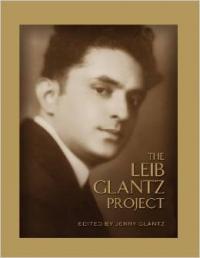By Jerry Glantz
 Leib Glantz wrote 216 compositions during his lifetime. They encompassed Cantorial music, Chassidic music and also Hebrew and Yiddish art songs.
Leib Glantz wrote 216 compositions during his lifetime. They encompassed Cantorial music, Chassidic music and also Hebrew and Yiddish art songs.
As a performing artist who mainly sang his own compositions, Glantz wrote the music the way he wanted to sing it himself. He was a lyric tenor with a vast vocal range and unique acoustic capabilities.
Following his untimely passing in Tel Aviv in 1964, the Board of Directors of the Tel Aviv Institute for Jewish Liturgical Music (founded by Glantz in 1959), decided to terminate the institute’s Cantors Academy and focus, instead, on becoming a publisher of Leib Glantz’s lectures, essays, articles and musical compositions.
In addition to the Hebrew book, Zeharim-In Memory of Leib Glantz, seven other volumes were published in the Rinat Ha’Kodesh Series – a collection of most of Glantz’s important compositions. Cantor Israel Alter and Yehoshua Zohar, Glantz’s long-time choir conductor, oversaw the project with David Loeb as editor. The series was co-published in the 1960s by the Israel Music Institute.
During the writing of The Man Who Spoke to God (2008), I discussed the Rinat Ha’Kodesh Series with composer, arranger, and accompanist, Raymond Goldstein, who maintained that the compositions in those volumes were not functional for contemporary cantors and performers.
My response was to invite Raymond to write an essay on this topic which I included in the book The Man Who Spoke to God. I then invited him to compose a series of new arrangements for Leib Glantz’s compositions. This developed into The Leib Glantz Project and culminated in the publication of The Leib Glantz Project, a 500-page book of text, original music scores and sound tracks on CDs, published by the Tel Aviv Institute for Jewish Liturgical Music in 2013.
Cantor Herstik, who had witnessed Glantz’s davening at the Tiferet Zvi Synagogue in Tel Aviv, was very enthusiastic about the idea of composing new arrangements, but made an important observation: “It is not sufficient to try to perform Leib Glantz’s compositions, even with new arrangements, unless the potential performer thoroughly understands what Glantz was thinking when he composed a particular work and where he was coming from. In other words, what was Glantz’s thought process when he was applying his musical interpretations to the prayer texts?”
Cantor Herstik, director of TACI (Tel Aviv Cantorial Institute), therefore, wrote introductions to most of the new arrangements explaining his understanding of Glantz’s creative process. These introductions are included in the Cantor Leib Glantz Sound ‘n Scores Collection.
A very special thanks to the members of the Editorial Board of the Leib Glantz Project – Raymond Goldstein, Cantor Naftali Herstik, Cantor Evan Cohen, Cantor Benjamin Maissner and Noam Brown.
The Leib Glantz Project is dedicated in honor of Cantor Yonia Glantz (1903-1962), Leib’s brother.
